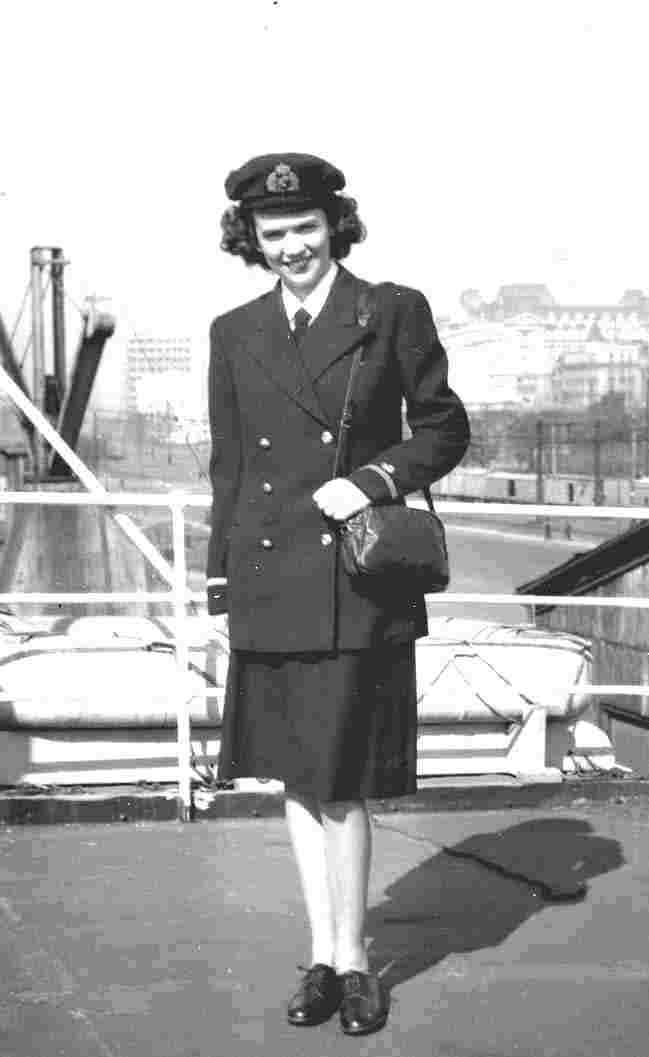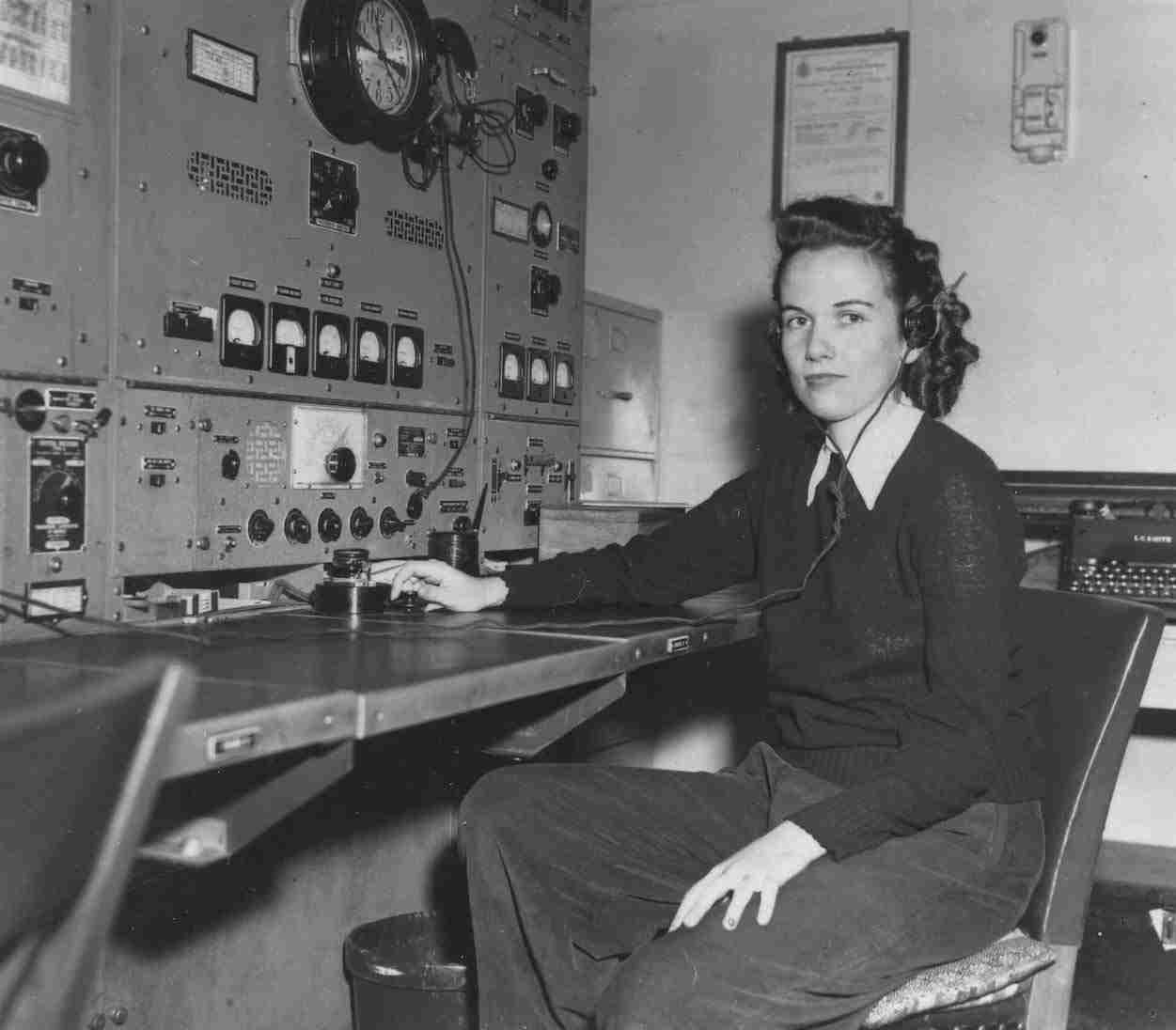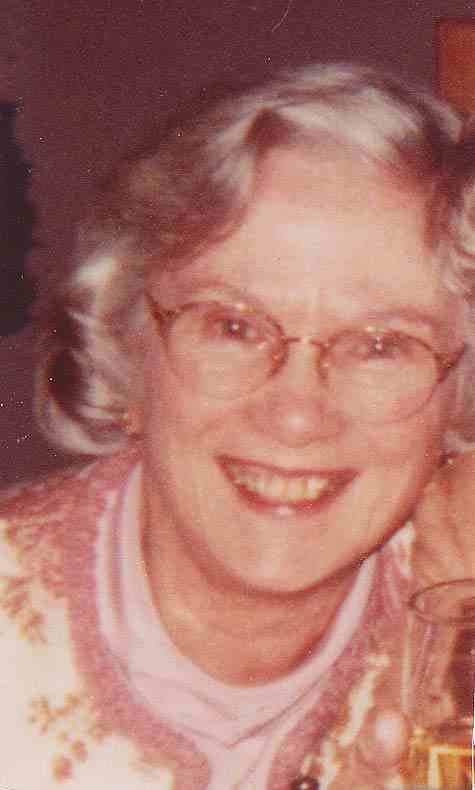

DEEP SEA YL 'SPARKS'
Story of YL Olive Carroll

For Olive Carroll of Vancouver, B.C., growing up in a seaport city had always kindled a desire to travel the world, to see what lay beyond the horizon. But the war was still being waged when she was at high school so her thoughts turned to joining one of the women's services upon graduation, preferably the navy.
With this in mind, and the hope of perhaps getting into the signals branch, Olive decided to join with qualifications and attended Sprott Shaw School of Wireless to earn her operator's licence. Here came a slight detour in her plans when she was put under contract to the Canadian Department of Transport as an interceptor operator. Upon obtaining her licence Olive was posted to VAI, the Pt. Grey Wireless Stn., where she had to learn Katakana, Japanese code. At war's end Olive moved to Victoria where she was employed as an interceptor operator with the Department of National Defence.
 Following three years service in this capacity with Canadian government departments, in April of 1947 Olive was notified of a vacancy aboard a vessel in San Francisco and jumped at the opportunity to full-fill her dream of going to sea as a ship's Sparks. Within days she flew off to San Francisco to sign aboard the Norwegian passenger freighter m/v Siranger as wireless officer.
Following three years service in this capacity with Canadian government departments, in April of 1947 Olive was notified of a vacancy aboard a vessel in San Francisco and jumped at the opportunity to full-fill her dream of going to sea as a ship's Sparks. Within days she flew off to San Francisco to sign aboard the Norwegian passenger freighter m/v Siranger as wireless officer.
A young, unworldly girl she admits, who had never been farther from home than 500 miles, had absolutely no knowledge of the sea or ships, or even of the language and customs of those with whom she would live and work - just a great desire to travel and work at her profession of wireless operator.
It therefore came as a considerable shock to learn
that not only was she the ship's wireless officer but her duties
included those of ship's purser and captain's secretary - all
of her work to be accomplished in Norwegian!
 But Olive was lucky as she was to discover; not only in the first captain she was to serve under, but in the ship she joined. Siranger was a trim, American wartime built vessel of just over 5,000 gross tons, launched in 1944. Her cabin was comfortable and the radio room and equipment, the RCA 4U Unit, an excellent layout.
But Olive was lucky as she was to discover; not only in the first captain she was to serve under, but in the ship she joined. Siranger was a trim, American wartime built vessel of just over 5,000 gross tons, launched in 1944. Her cabin was comfortable and the radio room and equipment, the RCA 4U Unit, an excellent layout.
The radio operator was somewhat unique aboard ship, being responsible to only one person - the skipper. It is the master of the ship who sets the mood on board. He can make any vessel a happy place to serve or � the exact opposite.
In all there were three captains with whom Olive sailed. First, kindly Captain Moy who treated her like a daughter and guided this fledgling Sparks. Erratic and unpredictable Captain Utne who was sacked by the owners when ship's personnel were on the point of mutiny, and lastly tight-fisted, irascible Captain Belt. All coloured, enlivened, and in various ways greatly effected her daily existence.

Adventures abounded (perhaps small 'a' adventures). Such as the Communist rebellion she walked into in Santiago, Chile, Evita's homecoming celebrations in Buenos Aires, Argentina, and Siranger's later port arrest in that city. A close-encounter with knife carrying toughs in Paranagua, Brazil, confrontation with the Soviet Army in Leningrad, meeting a maharajah and prince in Calcutta, four visits to Communist countries at a time when the Iron Curtain was firmly lowered across Eastern Europe - to mention just a few of those adventures.
It wasn't all fair weather sailing of course.
Olive and her fellow shipmates endured the usual rough seas and gales that are the lot of those who sail the oceans of the world. There was the tropical storm that struck while Siranger was anchored in Rio Bay. A hurricane in Basra, Iraq, that blew the ship and three other vessels across the river to the opposite bank. The winter storm off Finland's rocky coast when Siranger went aground and the ship's bottom was severely damaged. And the time during fierce weather near the Madeira Islands when welded seams in the hull opened, water got into the bunker oil, and the ship was without power and temporarily helpless.
Nor was life without it's share of accidents aboard; such as the men who were injured in a gale off Mozambique, one of whom Olive had to nurse until the ship reached Lagos, Nigeria, two weeks later. There were illnesses, altercations, the occasional drunken sailor running amok, and even a couple of attempted knifings. All these incidents, and more, Olive learned to take in her stride over the years.

Good times and bad and a lifetime of wonderful memories were packed into those years during which Olive saw much of the world. At first Siranger was on a regular run which originated and terminated on the west coast of the U. S., sometimes touching Canada, circled South America down the west coast, through the Strait of Magellan, up the east coast, through the Caribbean and Panama Canal and back to the west coast again. After a year and a half of what the crew called the Strait of Magellan ferry run Siranger was put on world wide charter, with following voyages covering almost all of the globe with the exception of the Orient and Australasia.
It was her radio work that gave Olive the greatest pleasure. It was constant, watch hours were full, and she had the satisfaction of knowing she was that important link between Siranger and the rest of the world. Combined with her purser and secretarial duties the hours were long and often arduous, the pay little, and conditions not always harmonious - but the experience was priceless.
Often being the only woman sailing with the crew of 35 men presented no problems at all. Olive was accepted as 'just one of the officers' and she considered equality one of the pluses of life at sea that she appreciated most.
And as fascinating as it was to visit foreign ports, meeting new people and learning of their cultures, there was always something so comforting in getting back to a daily routine at sea again. In Olive's words ... "In our own little world, remote from all else, the days rolled by more or less serenely."

After leaving the sea Olive 'discovered' her own country, travelling from the west to east coasts, as well as touring a number of times around Britain, Scandinavia and Europe.
Today she makes her home on a wooded acreage at the foot of True Blue Mtn., overlooking Kootenay Lake in the south-east corner of British Columbia. Here, with room for an antenna farm, Olive operates her amateur radio station VE7ERA.
For anyone interested in learning more of Olive's experiences and adventures at sea Cordillera Publishing Company of Vancouver published her book, Deep Sea 'Sparks', a Canadian girl in the Norwegian Merchant Navy in 1994. Some copies are still available and the company can be contacted at Box 46, 8415 Granville St., Vancouver, B.C., Canada, V6P 4Z9, telephone: (604) 261-1695 or Fax; (604) 266-4469.
For the technically minded the San Francisco Maritime Museum has re-created a ship's radio room which contains an RCA 4U set-up which Olive operated on Siranger. While the R/R layout differs the equipment is identical. This Website can be accessed at: http://www.nps.gov/safr/local/sparks.html

Thank You To:
Olive Roeckner VE7ERA - For Writing Her Story and Author of Deep Sea Sparks
Royal Canadian College (RCC) for 1942 First Graduating Class of
Wireless Operator's Photograph
Copyright
�

Back to Top

 YLRadio Home
YL
Archives
YLRadio Home
YL
Archives 

1999 - 2011